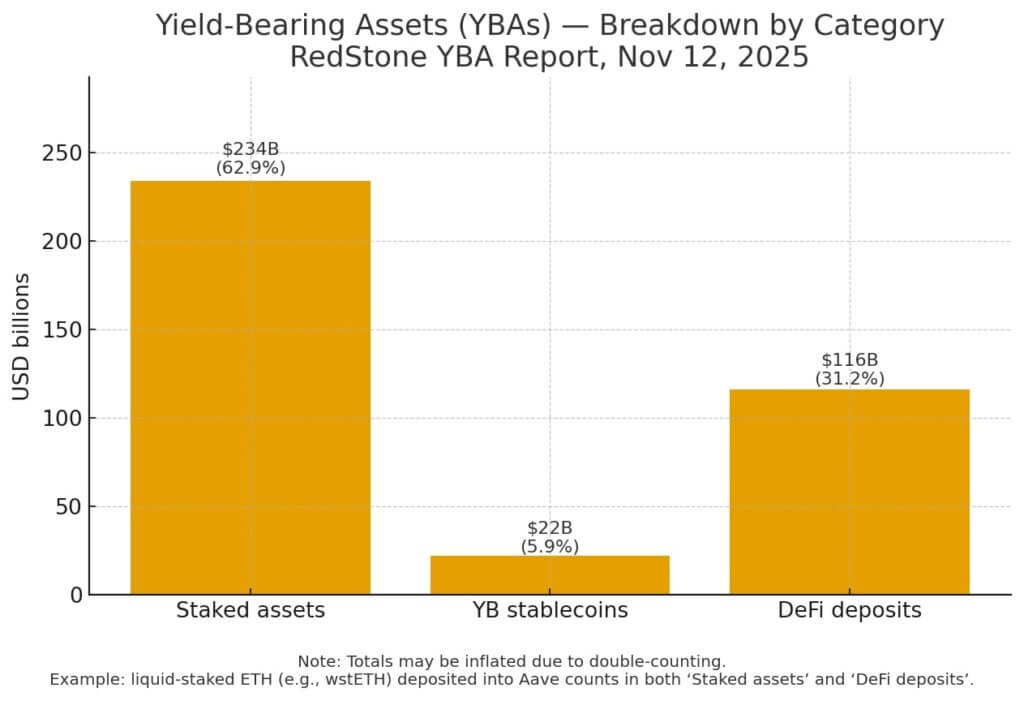Only 10% of crypto earns yield now — why most investors are sitting on dead money
Crypto has spent years building yield infrastructure, such as staking on Ethereum and Solana, yield-bearing stablecoins, DeFi lending protocols, and tokenized Treasuries.
The pipes already exist, the APYs are live, yet only 8% to 11% of the total crypto market generates yield today, compared to 55% to 65% of traditional financial (TradFi) assets, according to RedStone’s latest analysis.
That penetration gap isn’t a product problem, but rather a disclosure problem.
RedStone tallies roughly $300 billion to $400 billion of yield-bearing crypto assets against a $3.55 trillion total market capitalization to arrive at that 8% to 11% figure, with a caveat: the share is likely overstated because some positions get counted twice when staked assets are also deposited in DeFi protocols.
The comparison benchmark encompasses a wide range of investments, including corporate bonds, dividend equities, money-market funds, and structured credit.
TradFi’s advantage isn’t exotic instruments. It’s a century of standardized risk ratings, mandatory disclosure rules, and stress-testing frameworks that let institutions compare yield products on comparable terms.
Crypto has the products, but not the comparability, and that mismatch keeps institutional capital on the sidelines, even when yields run double digits.
Policy as catalyst, not solution
The GENIUS Act established a federal framework for payment stablecoins, requiring full reserve backing and oversight under the Bank Secrecy Act.
RedStone pointed to that clarity as the catalyst behind roughly 300% year-over-year growth in yield-bearing stablecoins, a segment that had stalled under regulatory uncertainty.
The law doesn’t mandate risk transparency, but addresses reserve composition and compliance, removing the binary question of whether stablecoins could operate in a legal gray zone.
That shift allowed issuers and platforms to move from “is this allowed?” to “how do we scale this?” and created the conditions for institutions to start asking more challenging questions about asset quality, collateral chains, and counterparty risk.
Independent coverage of the Act reflects a similar dynamic: regulation reduces uncertainty, but institutions still require more robust risk metrics before scaling up allocations. The law is necessary but not sufficient.
What’s missing is the apparatus that enables a treasury desk or asset manager to compare the risk-adjusted return of a yield-bearing stablecoin to that of a money-market fund, or to evaluate the credit exposure of a DeFi lending pool against a corporate bond ladder.
TradFi has that apparatus, with credit ratings, prospectuses, stress scenarios, and liquidity buckets. Crypto has APY leaderboards and TVL dashboards, which indicate where yield is generated, but not what risks underpin it.

Transparency deficit
RedStone’s analysis distills the problem into a single line: “The barrier to institutional adoption at scale is risk transparency.”
Unpack what that means in practice. First, there’s no comparable risk scoring across yield products. A 5% yield on staked ETH carries different liquidity, slashing, and smart contract risks than a 5% yield on a stablecoin backed by short-term Treasuries.
However, no standardized framework exists to quantify these differences.
Second, asset-quality breakdowns remain inconsistent. DeFi protocols disclose collateral ratios and liquidation thresholds, but tracking rehypothecation requires piecing together on-chain forensics and off-chain custodian reports.
Third, oracle and validator dependencies are rarely disclosed with the rigor TradFi applies to operational risk.
A yield product that depends on a single price feed or a small validator set carries concentration risk that isn’t surfaced in user-facing dashboards.
Then there’s the double-counting issue that RedStone explicitly flags. When staked ETH is wrapped, deposited into a lending protocol, and then used as collateral for another position, TVL metrics increase, and “yield-bearing” percentages overstate the actual capital deployed.
Traditional finance accounting rules separate principal from derivative exposure. Crypto’s on-chain transparency creates the opposite problem, with everything being visible, but aggregating it into meaningful risk metrics requires infrastructure that doesn’t yet exist at scale.
Closing the gap
The next leg isn’t about inventing new yield products. Staked blue chip assets, yield-bearing stablecoins, and tokenized government debt already cover the risk spectrum, ranging from variable to fixed, and from decentralized to custodial.
What’s needed is the measurement layer: standardized risk disclosures, third-party audits of collateral and counterparty exposure, and uniform treatment of rehypothecation and double-counting in reported metrics.
That’s not a technical problem, since on-chain data is auditable by design, but it requires coordination across issuers, platforms, and auditors to build frameworks that institutions recognize as credible.
Crypto’s yield pipes now exist. Staking on proof-of-stake networks delivers predictable returns tied to network security. Yield-bearing stablecoins offer dollar-denominated income with varying degrees of reserve transparency.
DeFi protocols offer variable rates that are driven by the supply and demand for specific assets. The 8% to 11% penetration rate isn’t a signal that crypto lacks yield opportunities.
It’s a signal that the risk attached to those opportunities isn’t legible to the allocators who control the bulk of global capital.
TradFi’s yield penetration didn’t emerge because traditional assets are inherently safer, but rather because their risks are measured, disclosed, and comparable.
Until crypto builds that measurement layer, the adoption bottleneck won’t be product gaps or regulatory ambiguity, but the inability to answer what is at risk for the yield.
Disclaimer: The content of this article solely reflects the author's opinion and does not represent the platform in any capacity. This article is not intended to serve as a reference for making investment decisions.
You may also like
Bitcoin Latest Updates: Major Investors Increase Their Holdings, Keeping Bitcoin Steady Over $105K Despite $1.7B ETF Withdrawals
- Bitcoin stabilizes above $105,000 amid a falling wedge pattern on 4-hour charts, with analysts eyeing a potential $120,000 breakout if key resistance is breached. - Whale activity (holders of >10,000 BTC) doubled holdings by 36,000 BTC, countering $1.7B ETF outflows and anchoring prices above $100,000 despite mid-sized investor exits. - Macroeconomic factors—including U.S. government shutdown resolution and Fed pause expectations—bolster risk-on sentiment, while Bitcoin’s decoupling from NASDAQ and M2 mo

Hyperliquid News Today: ZKP Leads Crypto’s Transformation from Speculative Trading to Efficient, Privacy-Focused Computing
- ZKP, a self-funded decentralized compute network, claims $100M infrastructure to outpace Ethereum and Hyperliquid with immediate utility via hardware-based Proof Pods. - The project secured $17M in pre-orders for plug-and-play Pods generating on-chain rewards, contrasting with competitors' phased upgrades and speculative models. - Rising institutional interest in privacy coins like Zcash (ZEC) highlights shifting capital toward privacy-focused assets as ZKP bridges AI and blockchain with transparent earn

ZKP Disrupts Traditional Crypto Standards Through Open Auctions
- ZKP introduces a crypto presale model using daily on-chain auctions to eliminate insider advantages and prioritize market-driven price discovery. - The project allocates 200 million tokens daily via proportional contributions, with a $50,000 cap to prevent market manipulation by large investors. - Unlike traditional presales, ZKP has no private allocations, team unlocks, or venture capital deals, ensuring equal access for all participants. - Custom Proof Pods validate cryptographic proofs and earn reward

Bitcoin News Update: Cash App Connects Users to Global Finance Using Bitcoin and Stablecoins
- Cash App, operated by Block Inc. , introduces Bitcoin Lightning Network and stablecoin payments, aiming to boost mainstream adoption of digital assets for everyday transactions. - The updates enable 58 million users to send/receive Bitcoin instantly and low-cost, while merchants can accept BTC in multiple formats without fees until 2027. - Stablecoin support via Solana’s USDC aligns with the GENIUS Act, enhancing fast, dollar-pegged transactions and regulatory clarity for merchants and consumers. - Block

